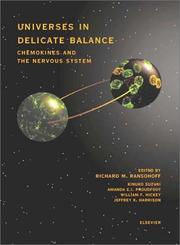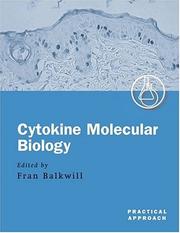| Listing 1 - 10 of 88 | << page >> |
Sort by
|
Book
Year: 2018 Publisher: Basel : MDPI - Multidisciplinary Digital Publishing Institute,
Abstract | Keywords | Export | Availability | Bookmark
 Loading...
Loading...Choose an application
- Reference Manager
- EndNote
- RefWorks (Direct export to RefWorks)
A hallmark of inflammation is the accumulation of leukocytes, which can serve to remove pathogens and necrotic tissue, but may also damage healthy tissue and exacerbate the inflammatory response. Our understanding of leukocyte recruitment in inflammation was revolutionized in the late 1980s by the discovery of chemokines (chemotactic cytokines), a family of small, secreted proteins that induce migration of selective subsets of leukocytes. Shortly afterwards, chemokines were found to exert their functions through the now familiar chemokine receptors, members of the G protein-coupled receptor superfamily. As their physiological and pathological functions were elucidated, chemokine receptors have become popular targets for drug development in inflammatory diseases as well as cancer metastasis and HIV infection. Extensive research has revealed that the functions of chemokines and their receptors are regulated at numerous levels, including: genetic mutations/polymorphisms; control of expression levels; ligand internalization via functional or decoy receptors; intrinsic selectivity of chemokine-receptor binding; hetero- or homo-oligomerization of chemokines or of receptors; alternative signalling pathways; interaction of chemokines with glycosaminoglycans; post-translational modifications; and binding to pathogen-derived inhibitors. This Special Issue of IJMS focused on the natural and pharmacological mechanisms by which the activities of chemokines and their receptors can be regulated.
Book
Year: 2018 Publisher: Basel : MDPI - Multidisciplinary Digital Publishing Institute,
Abstract | Keywords | Export | Availability | Bookmark
 Loading...
Loading...Choose an application
- Reference Manager
- EndNote
- RefWorks (Direct export to RefWorks)
A hallmark of inflammation is the accumulation of leukocytes, which can serve to remove pathogens and necrotic tissue, but may also damage healthy tissue and exacerbate the inflammatory response. Our understanding of leukocyte recruitment in inflammation was revolutionized in the late 1980s by the discovery of chemokines (chemotactic cytokines), a family of small, secreted proteins that induce migration of selective subsets of leukocytes. Shortly afterwards, chemokines were found to exert their functions through the now familiar chemokine receptors, members of the G protein-coupled receptor superfamily. As their physiological and pathological functions were elucidated, chemokine receptors have become popular targets for drug development in inflammatory diseases as well as cancer metastasis and HIV infection. Extensive research has revealed that the functions of chemokines and their receptors are regulated at numerous levels, including: genetic mutations/polymorphisms; control of expression levels; ligand internalization via functional or decoy receptors; intrinsic selectivity of chemokine-receptor binding; hetero- or homo-oligomerization of chemokines or of receptors; alternative signalling pathways; interaction of chemokines with glycosaminoglycans; post-translational modifications; and binding to pathogen-derived inhibitors. This Special Issue of IJMS focused on the natural and pharmacological mechanisms by which the activities of chemokines and their receptors can be regulated.
Book
ISBN: 1803561742 Year: 2023 Publisher: London : IntechOpen,
Abstract | Keywords | Export | Availability | Bookmark
 Loading...
Loading...Choose an application
- Reference Manager
- EndNote
- RefWorks (Direct export to RefWorks)
This book provides an overview of some of the latest developments in the medical sciences, with particular emphasis on the experimental and theoretical aspects of modern medicine. In recent years, researchers working in applied health sciences have been able to identify diseases indicated by chemokines. Among the topics discussed in this book are chemokines affecting platelet functions, cytokine levels, and oxidative stress parameters in COVID-19, chemokines at the intersection of diabetes-tuberculosis synergy, chemokines in periodontal diseases, pathogenic links between hepato-digestive disorders and periodontal conditions, and IL-inflammatory carcinogenesis. Other areas included are the role of 23 receptor gene variations, the relationship between interleukin-5 Receptor polymorphism, and immunological parameters in children with asthma. The book's primary target audience includes students, researchers, medical practitioners, dentists, pharmacologists, and professionals interested in related fields. The book has been written by expert international scientists active in research in the health and applied sciences. We hope it will increase scientists' knowledge of the complexity of some medical approaches, and encourage both professionals and students to devote part of their future research to understanding the mechanisms and applications of chemokines.

ISBN: 9780444510020 0444510028 1423755472 9781423755470 0080520197 9780080520193 128102838X 9781281028389 9786611028381 Year: 2002 Publisher: Amsterdam New York Elsevier
Abstract | Keywords | Export | Availability | Bookmark
 Loading...
Loading...Choose an application
- Reference Manager
- EndNote
- RefWorks (Direct export to RefWorks)
It is commonly acknowledged that the nervous system and the immune system, those most complex of networks, share attributes beyond their intricacy. Elements common to the two systems include memory, connectivity, flexibility and developmental selection of cellular composition by a rigorous process involving widespread programmed cell death. There is one salient difference: the cells of the immune system are predominantly in constant motion, while post-mitotic neurons and glia are largely fixed in place. Therefore, chemokines, initially characterized as leukocyte chemoattractants, have for t

ISBN: 0121821889 9780121821883 Year: 1997 Volume: 287 Publisher: London ; Boston ; Tokyo Academic press
Abstract | Keywords | Export | Availability | Bookmark
 Loading...
Loading...Choose an application
- Reference Manager
- EndNote
- RefWorks (Direct export to RefWorks)
Enzymology --- Chemokinen --- Chemokines --- Chimokines --- Inflammatory cytokines --- Chimiokines
Book
ISBN: 030644710X 1461362830 1461529522 Year: 1993 Volume: 351 Publisher: New York Plenum Press
Abstract | Keywords | Export | Availability | Bookmark
 Loading...
Loading...Choose an application
- Reference Manager
- EndNote
- RefWorks (Direct export to RefWorks)
Chemokines --- Congresses --- Chemokines - Congresses. --- Chemotactic factors --- Chemotaxis, leukocyte --- Cytokines --- Inflammation --- Interleukin-8
Book
ISBN: 0128021950 0128021713 Year: 2016 Publisher: Amsterdam, [Netherlands] : Academic Press,
Abstract | Keywords | Export | Availability | Bookmark
 Loading...
Loading...Choose an application
- Reference Manager
- EndNote
- RefWorks (Direct export to RefWorks)
Chemokines. --- Chemokines --- Chemotactic cytokines --- Inflammatory peptides --- Intercrines --- Cytokines --- Inflammation --- Peptides --- Physiological effect. --- Mediators
Multi
ISBN: 293040423X Year: 2005 Publisher: Liège Université de Liège. Faculté de médecine vétérinaire
Abstract | Keywords | Export | Availability | Bookmark
 Loading...
Loading...Choose an application
- Reference Manager
- EndNote
- RefWorks (Direct export to RefWorks)
Chemokines --- Dna, viral --- Herpes viridae --- Varicellovirus --- Metabolism --- Chemistry

ISBN: 0199638578 0199638586 Year: 2000 Publisher: Oxford : Oxford university press,
Abstract | Keywords | Export | Availability | Bookmark
 Loading...
Loading...Choose an application
- Reference Manager
- EndNote
- RefWorks (Direct export to RefWorks)
Cytokines. --- Gene amplification. --- Genetic Techniques. --- Genetic Techniques --- Chemokines --- Cytokines
Book
ISBN: 9782889197682 Year: 2016 Publisher: Frontiers Media SA
Abstract | Keywords | Export | Availability | Bookmark
 Loading...
Loading...Choose an application
- Reference Manager
- EndNote
- RefWorks (Direct export to RefWorks)
It is now accepted that immune molecules are not only present within the brain during pathology but they exert physiological functions in the "healthy" brain as well. Increasing evidence points to a neuro-modulatory role of cytokines and chemokines (CHEMOtactic cytoKINES) in basal transmission and plasticity processes where signaling between peri-synaptic astrocytes, microglia and neurons plays an important role. Nevertheless, the exact mechanisms as to how cytokines, and in particular chemokines, participate in the molecular and cellular processes thought to subserve memory formation, plasticity processes and responsiveness to environmental stimuli remain to be clarified. Interestingly, in in vitro preparations, molecules like TNF-a, interleukin (IL)-1ß, IL-6, CX3CL1, CXCL12, CCL2 and CCL3 are implicated in synaptic formation and scaling, in modulation of glutamatergic transmission, in plasticity and neurogenesis, in particular in the hippocampus. The hippocampus is an extremely plastic structure, one of the main neurogenic niches in the adult brain, that exhibits a marked sensibility to environmental stimuli. Indeed exposure of mice to environmental enrichment (EE) modifies learning and memory abilities increasing neurogenesis and neuronal plasticity whether exposure to severe stressful experiences diminishes neurotrophic support, impairs neurogenesis, plasticity and cognition. In the hippocampus cytokines play a key role in mediating both positive as well as negative effects of the environment affecting neuronal plasticity also in stress related pathologies, such as depression. It has been reported that mice lacking type 1 receptor for IL-1 display impaired hippocampal memory and LTP that are restored by EE; moreover negative effects on neuronal plasticity (and thus behavior) induced by stress exposure can be prevented by blocking IL-1 activity. In addition, mice lacking IL-6 have improved cognitive functions whereas the absence of microglia-driven CX3CR1 signaling increases hippocampal plasticity and spatial memory occluding the potentiating effects of EE. However, the factors mediating the effect of environmental stimuli on behavior and plasticity has been only partially identified. Interestingly, it has been suggested that chemokines can play a key role in the flexibility of hippocampal structure and may modulate neuronal signaling during behavior. The question is how cytokines may translate environmental stimuli in plasticity and behavioral changes. This research topic is proposed to explore the role of cytokines, and more in particular chemokines, in the modulation of neuronal activity as a fundamental step for the correct brain wiring, function and susceptibility to environment. We encourage the submission of original research reports, review articles, commentaries, perspectives or short communications, in the following (but not limited to) topics: - Role of cytokines and chemokines in neuronal plasticity - Immune molecules and responsiveness to environment - Role of chemokine in the flexibility of hippocampal structure
cytokine --- environment --- development --- Neurons --- Astrocytes --- Neuronal Plasticity --- Behavior --- Chemokines --- Microglia
| Listing 1 - 10 of 88 | << page >> |
Sort by
|

 Search
Search Feedback
Feedback About
About Help
Help News
News